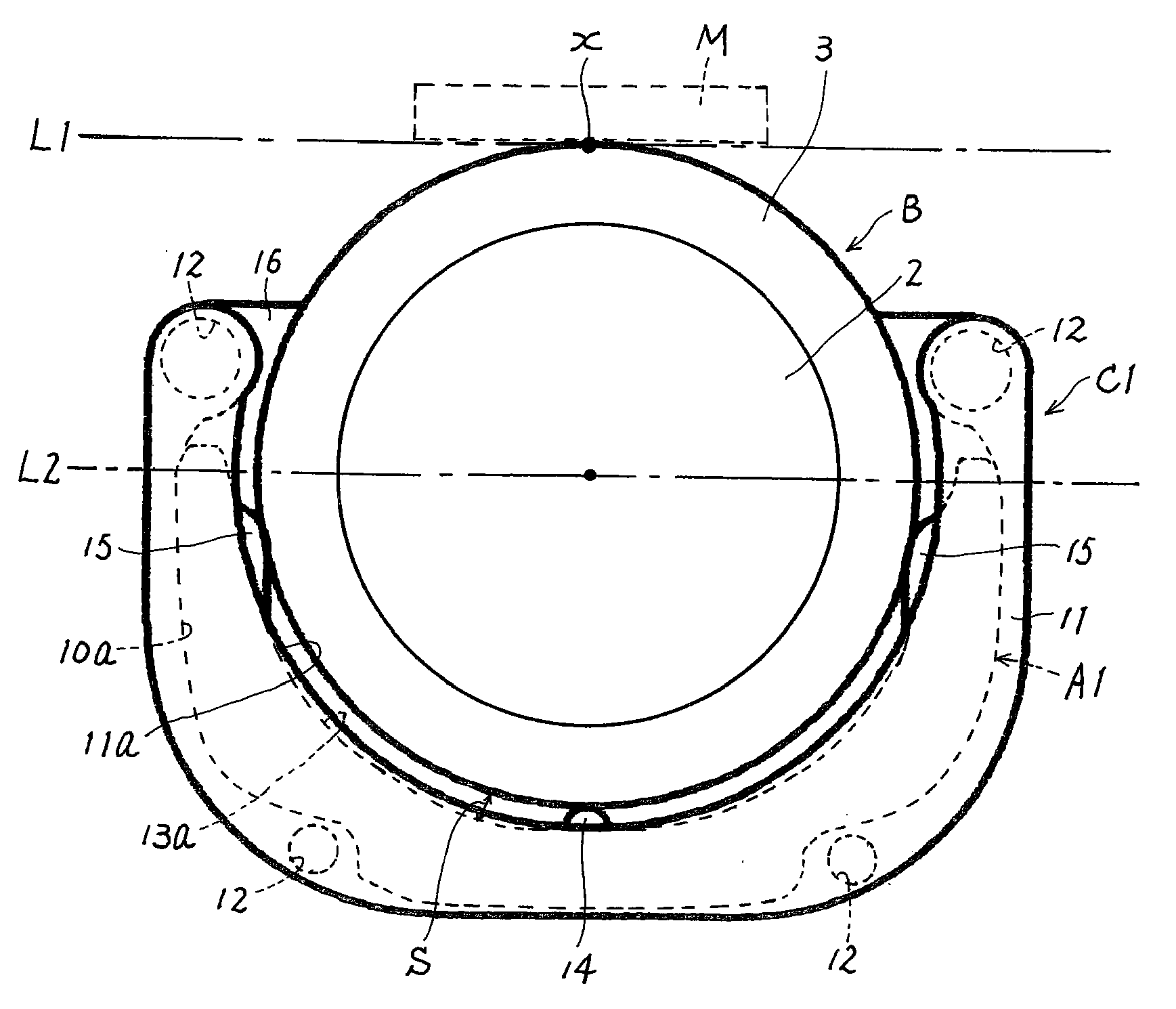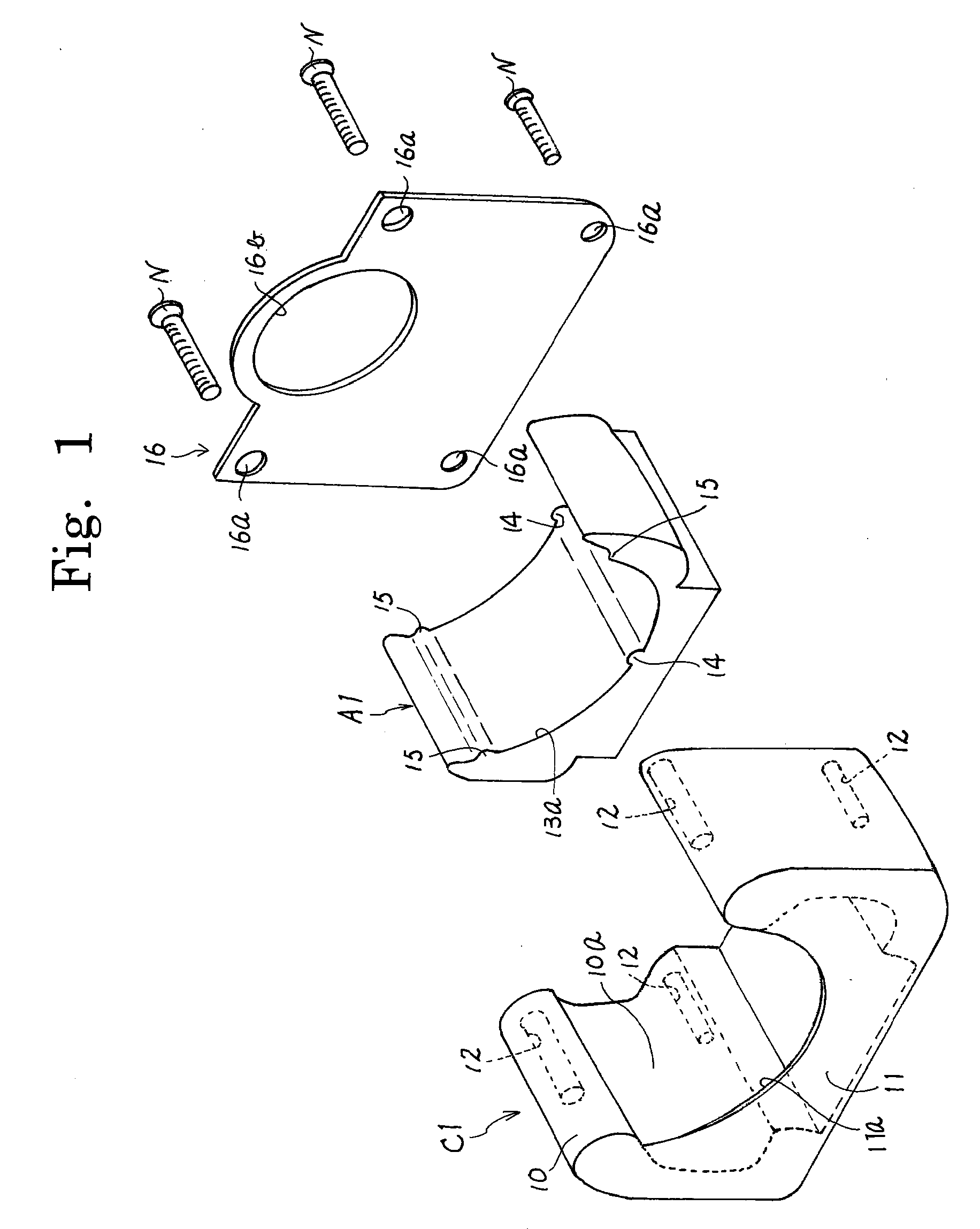Bearing Lubricating Device
a lubricating device and bearing technology, applied in the direction of crankshafts, mechanical devices, engine components, etc., can solve the problems of increasing the manufacturing cost of the conventional lubricating device, the assembly process for fixing the lubricating device to the bearing is complicated, etc., to reduce the size of the lubricating member, reduce the amount of lubricant, and reduce the effect of manufacturing cos
- Summary
- Abstract
- Description
- Claims
- Application Information
AI Technical Summary
Benefits of technology
Problems solved by technology
Method used
Image
Examples
first embodiment
[0042]In the lubricating device because the lubricating member A1 and the outer ring 3 are in contact with each other below the center line L2, the need for the lubricating member A1 to extend above the center line L2 is eliminated, thus reducing the size of the lubricating member A1.
[0043]Even if the lubricating member A1 is reduced in size, the lubricating member A1 can hold sufficient lubricant to match the service life of the bearing B. As a result, the size reduction of the lubricating member A1 enables a reduction in manufacturing costs without affecting the lubrication of the outer ring 3.
[0044]In addition, because a clearance S is created between the outer ring 3 and the lubricating member A1, dust and the like involved with the rotation of the outer ring 3 can be collected in the clearance S.
second embodiment
[0045]Next, FIGS. 4A and 4B illustrate the present invention, which will be described below.
[0046]The lubricating device according to the second embodiment differs from the lubricating device of the first embodiment in the shape of the lubricating member and the shape of the casing, but is identical in the structure and the operation of the main body 10, side portion 11, recess 11a, screw holes 12, lubricant protrusion portions 14, 15, plate member 16, screw holes 16a support-shaft hole 16b, fixing member 17 and the nut 18. Therefore, the same structural components in the second embodiment as those in the first embodiment are designated with the same reference numerals. The second embodiment will be described with emphasis on the differences from the first embodiment. Note that the side view of FIG. 2 described in the first embodiment holds good for the second embodiment.
[0047]The lubricating device comprises, as illustrated in FIG. 4A, a casing C2, a lubricating member A2 fitted in...
third embodiment
[0059]Next, the present invention will be described with reference to FIG. 5A and FIG. 5B.
[0060]The lubricating device according to the third embodiment differs from the lubricating device of the second embodiment in that an elastic member, as described below, is provided, but is identical in the structure and the operation of the other components. Therefore, the same structural components in the third embodiment as those in the second embodiment are designated with the same reference numerals. The third embodiment will be described with emphasis on the differences from the second embodiment.
[0061]As shown in FIGS. 5A and 5B, in the lubricating device, when the lubricating member A2 is fitted into the recess 19 of the casing C2, an elastic member 21 in the form of a leaf spring is interposed between the bottom of the casing C2 and the lubricating member A2.
[0062]Accordingly, once the lubricating device is fixed to the bearing B, the lubricating member A2 is pressed against the outer...
PUM
 Login to View More
Login to View More Abstract
Description
Claims
Application Information
 Login to View More
Login to View More - R&D
- Intellectual Property
- Life Sciences
- Materials
- Tech Scout
- Unparalleled Data Quality
- Higher Quality Content
- 60% Fewer Hallucinations
Browse by: Latest US Patents, China's latest patents, Technical Efficacy Thesaurus, Application Domain, Technology Topic, Popular Technical Reports.
© 2025 PatSnap. All rights reserved.Legal|Privacy policy|Modern Slavery Act Transparency Statement|Sitemap|About US| Contact US: help@patsnap.com



